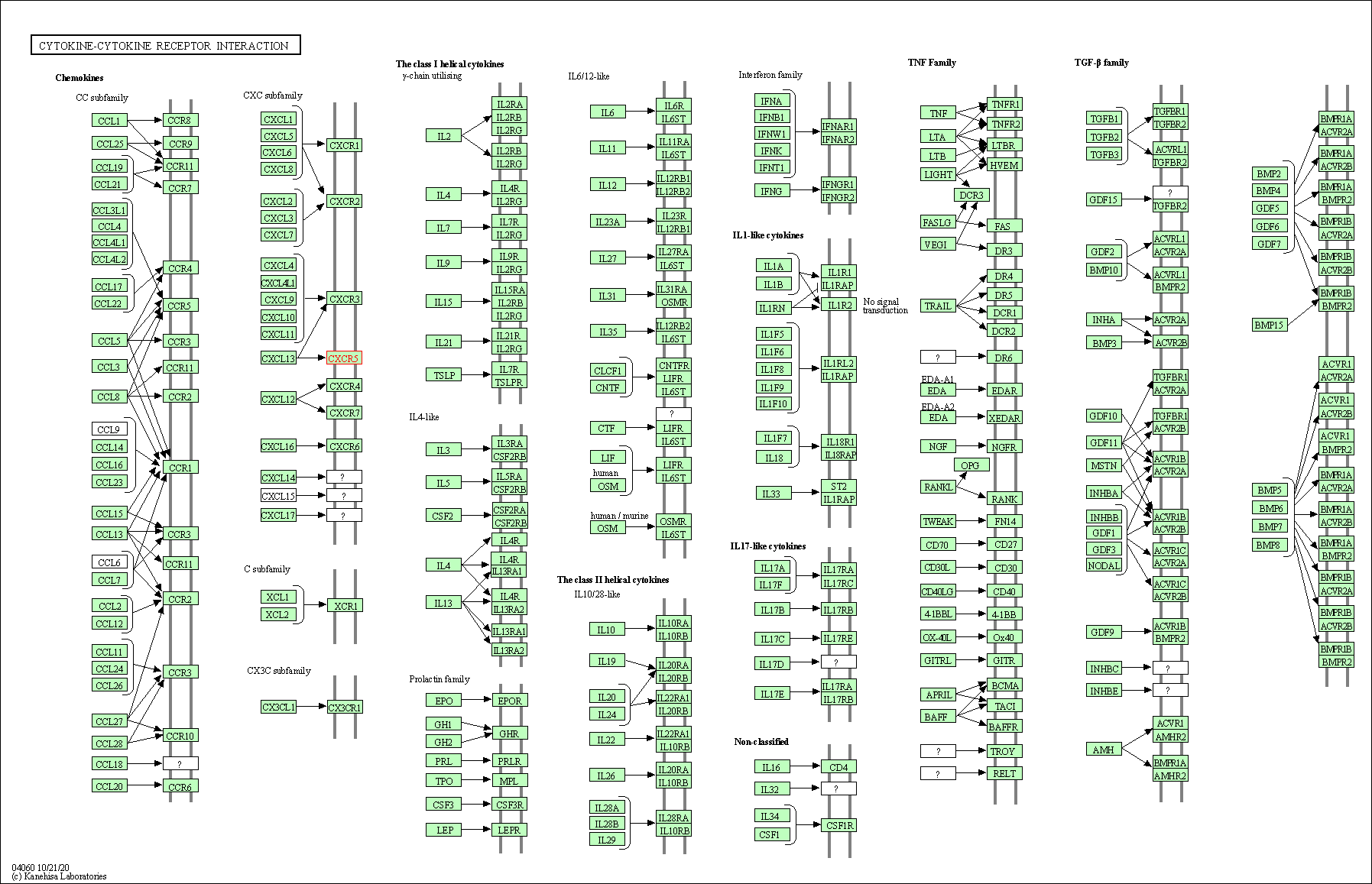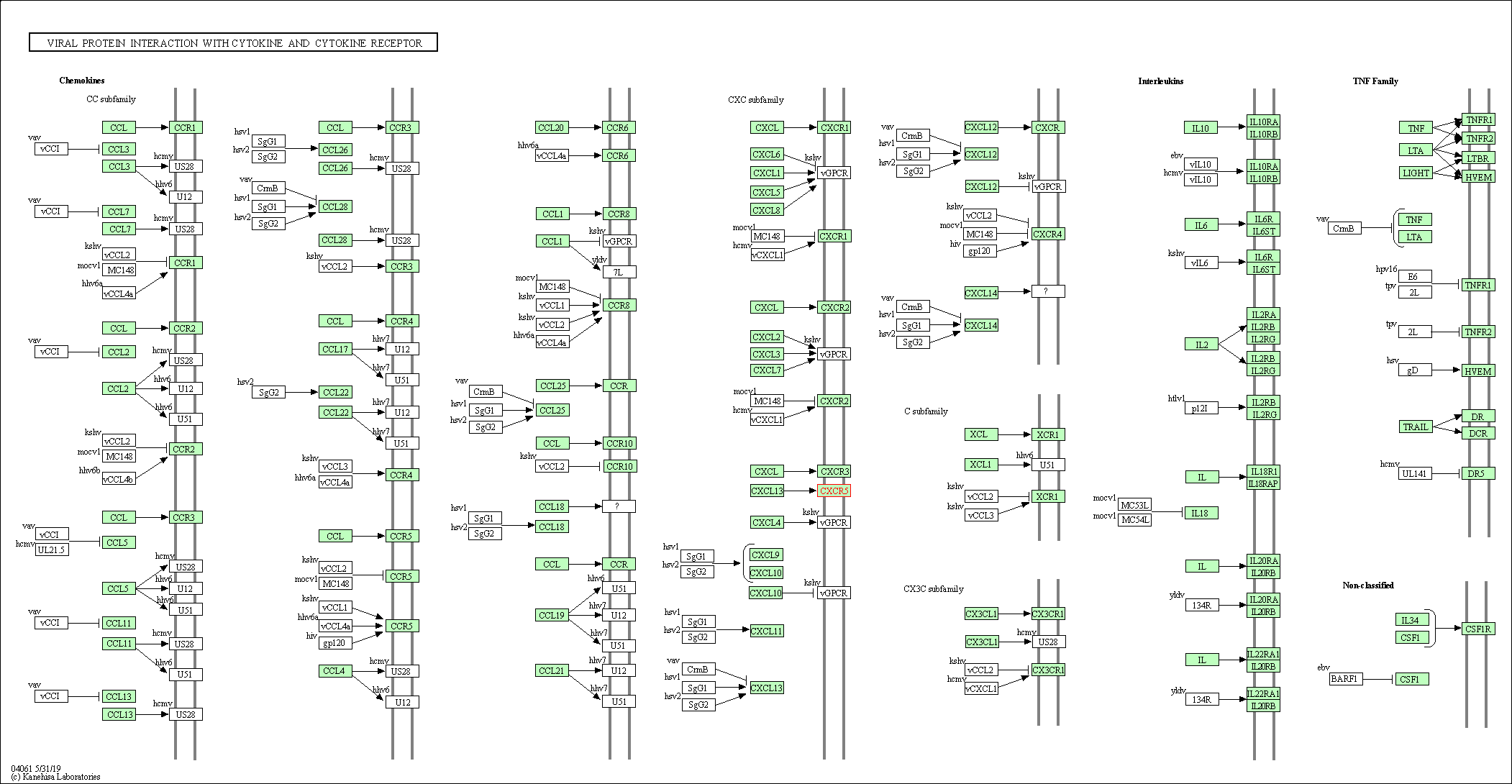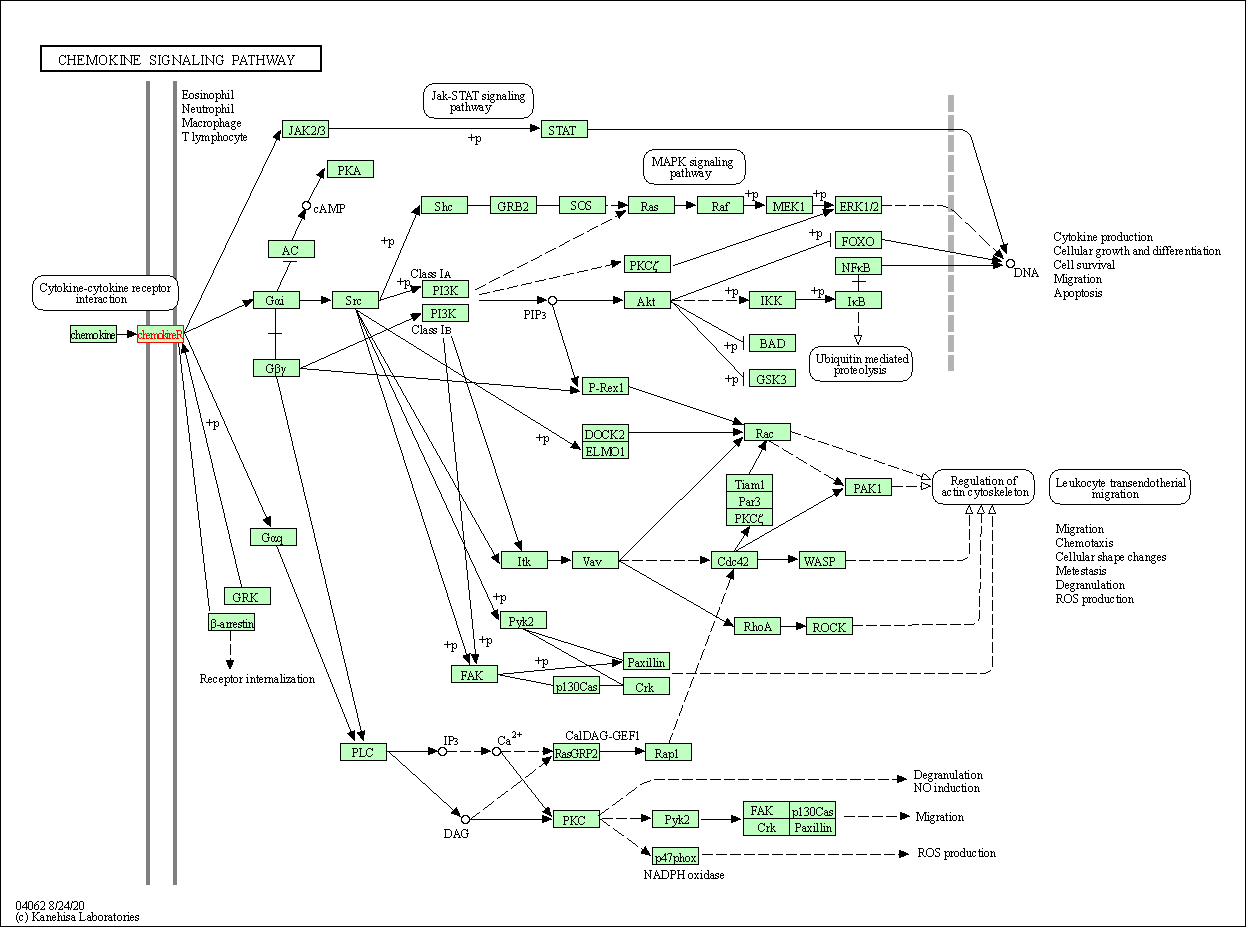Target Information
| Target General Information | Top | |||||
|---|---|---|---|---|---|---|
| Target ID |
T09528
(Former ID: TTDR00287)
|
|||||
| Target Name |
C-X-C chemokine receptor type 5 (CXCR5)
|
|||||
| Synonyms |
Monocyte-derived receptor15; Monocyte-derived receptor 15; MDR15; MDR-15; Chemokine receptor CXCR5; CXCR-5; CXC-R5; CD185; Burkitt'S lymphoma receptor 1; Burkitt lymphoma receptor 1; BLR1
Click to Show/Hide
|
|||||
| Gene Name |
CXCR5
|
|||||
| Target Type |
Clinical trial target
|
[1] | ||||
| Disease | [+] 2 Target-related Diseases | + | ||||
| 1 | Thrombocytopenia [ICD-11: 3B64] | |||||
| 2 | Lupus erythematosus [ICD-11: 4A40] | |||||
| Function |
Involved in B-cell migration into B-cell follicles of spleen and Peyer patches but not into those of mesenteric or peripheral lymph nodes. May have a regulatory function in Burkitt lymphoma (BL) lymphomagenesis and/or B-cell differentiation. Cytokine receptor that binds to B-lymphocyte chemoattractant (BLC).
Click to Show/Hide
|
|||||
| BioChemical Class |
GPCR rhodopsin
|
|||||
| UniProt ID | ||||||
| Sequence |
MNYPLTLEMDLENLEDLFWELDRLDNYNDTSLVENHLCPATEGPLMASFKAVFVPVAYSL
IFLLGVIGNVLVLVILERHRQTRSSTETFLFHLAVADLLLVFILPFAVAEGSVGWVLGTF LCKTVIALHKVNFYCSSLLLACIAVDRYLAIVHAVHAYRHRRLLSIHITCGTIWLVGFLL ALPEILFAKVSQGHHNNSLPRCTFSQENQAETHAWFTSRFLYHVAGFLLPMLVMGWCYVG VVHRLRQAQRRPQRQKAVRVAILVTSIFFLCWSPYHIVIFLDTLARLKAVDNTCKLNGSL PVAITMCEFLGLAHCCLNPMLYTFAGVKFRSDLSRLLTKLGCTGPASLCQLFPSWRRSSL SESENATSLTTF Click to Show/Hide
|
|||||
| 3D Structure | Click to Show 3D Structure of This Target | AlphaFold | ||||
| Drugs and Modes of Action | Top | |||||
|---|---|---|---|---|---|---|
| Clinical Trial Drug(s) | [+] 1 Clinical Trial Drugs | + | ||||
| 1 | SAR113244 | Drug Info | Phase 1 | Systemic lupus erythematosus | [3] | |
| Mode of Action | [+] 1 Modes of Action | + | ||||
| Modulator | [+] 1 Modulator drugs | + | ||||
| 1 | SAR113244 | Drug Info | [1] | |||
| Cell-based Target Expression Variations | Top | |||||
|---|---|---|---|---|---|---|
| Cell-based Target Expression Variations | ||||||
| Different Human System Profiles of Target | Top |
|---|---|
|
Human Similarity Proteins
of target is determined by comparing the sequence similarity of all human proteins with the target based on BLAST. The similarity proteins for a target are defined as the proteins with E-value < 0.005 and outside the protein families of the target.
A target that has fewer human similarity proteins outside its family is commonly regarded to possess a greater capacity to avoid undesired interactions and thus increase the possibility of finding successful drugs
(Brief Bioinform, 21: 649-662, 2020).
Human Pathway Affiliation
of target is determined by the life-essential pathways provided on KEGG database. The target-affiliated pathways were defined based on the following two criteria (a) the pathways of the studied target should be life-essential for both healthy individuals and patients, and (b) the studied target should occupy an upstream position in the pathways and therefore had the ability to regulate biological function.
Targets involved in a fewer pathways have greater likelihood to be successfully developed, while those associated with more human pathways increase the chance of undesirable interferences with other human processes
(Pharmacol Rev, 58: 259-279, 2006).
Biological Network Descriptors
of target is determined based on a human protein-protein interactions (PPI) network consisting of 9,309 proteins and 52,713 PPIs, which were with a high confidence score of ≥ 0.95 collected from STRING database.
The network properties of targets based on protein-protein interactions (PPIs) have been widely adopted for the assessment of target’s druggability. Proteins with high node degree tend to have a high impact on network function through multiple interactions, while proteins with high betweenness centrality are regarded to be central for communication in interaction networks and regulate the flow of signaling information
(Front Pharmacol, 9, 1245, 2018;
Curr Opin Struct Biol. 44:134-142, 2017).
Human Similarity Proteins
Human Pathway Affiliation
Biological Network Descriptors
|
|
| KEGG Pathway | Pathway ID | Affiliated Target | Pathway Map |
|---|---|---|---|
| Cytokine-cytokine receptor interaction | hsa04060 | Affiliated Target |

|
| Class: Environmental Information Processing => Signaling molecules and interaction | Pathway Hierarchy | ||
| Viral protein interaction with cytokine and cytokine receptor | hsa04061 | Affiliated Target |

|
| Class: Environmental Information Processing => Signaling molecules and interaction | Pathway Hierarchy | ||
| Chemokine signaling pathway | hsa04062 | Affiliated Target |

|
| Class: Organismal Systems => Immune system | Pathway Hierarchy | ||
| Degree | 1 | Degree centrality | 1.07E-04 | Betweenness centrality | 0.00E+00 |
|---|---|---|---|---|---|
| Closeness centrality | 1.56E-01 | Radiality | 1.22E+01 | Clustering coefficient | 0.00E+00 |
| Neighborhood connectivity | 5.00E+00 | Topological coefficient | 1.00E+00 | Eccentricity | 13 |
| Download | Click to Download the Full PPI Network of This Target | ||||
| Chemical Structure based Activity Landscape of Target | Top |
|---|---|
| Target Regulators | Top | |||||
|---|---|---|---|---|---|---|
| Target-interacting Proteins | ||||||
| References | Top | |||||
|---|---|---|---|---|---|---|
| REF 1 | Interpreting expression profiles of cancers by genome-wide survey of breadth of expression in normal tissues. Genomics 2005 Aug;86(2):127-41. | |||||
| REF 2 | ClinicalTrials.gov (NCT05070845) AN INTERVENTIONAL PHASE 2, OPEN-LABEL, MULTI-CENTER STUDY TO EVALUATE SAFETY AND EFFICACY OF PF-06835375 IN ADULT PARTICIPANTS WITH MODERATE TO SEVERE PRIMARY IMMUNE THROMBOCYTOPENIA. U.S.National Institutes of Health. | |||||
| REF 3 | ClinicalTrials.gov (NCT02321709) Multiple Ascending Dose Study To Assess The Safety Profile Of SAR113244 Versus Placebo In Lupus Male And Female Patients. U.S. National Institutes of Health. | |||||
| REF 4 | Clinical pipeline report, company report or official report of Jyant Technologies. | |||||
If You Find Any Error in Data or Bug in Web Service, Please Kindly Report It to Dr. Zhou and Dr. Zhang.

